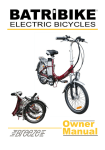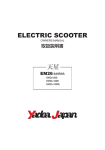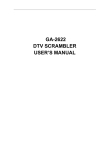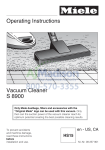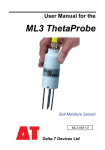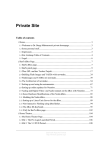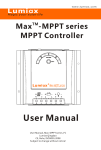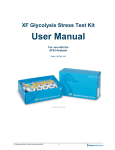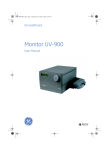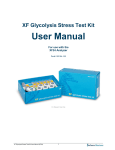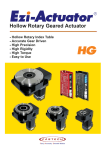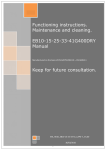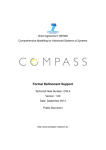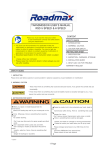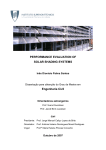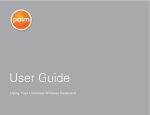Download EB04/ YD-EB05/ YD-EB06/ YD
Transcript
684 West Maude Avenue Sunnyvale, CA 94085 Tel. (650) 988-0900 Fax (650) 988-6647 www.ecmg-global.com S AFETY T EST R EPORT Pruduct Name: Electric Bicycle (Vehicle) Model Number: YD-EB01/ YD-EB02/ YDEB04/ YD-EB05/ YD-EB06/ YD-EB10 Trade Mark: YADEA Prepared for Jiangsu Yadea Technical Development Co., Ltd. According to EN 15194:2009 Cycles – Electrically power assisted cycles – EPAC Bicycles Test Report #: JIA-0909-8334-SAFETY_EN15194 Prepared by: Henry Wu Reviewed by: Neilson Yao QC Manager: Paul Chen Test Report Released By: 2009, October 15 Paul Chen Date TEST REPORT per EN 15194:2009 Cycles – Electrically power assisted cycles – EPAC Bicycles Administrative Data Report No. ...................................... : JIA-0909-8334-SAFETY_EN15194 Tested by (name and signature).......: Henry Wu Approved by (name and signature) ..: Neilson Yao Date of issue .....................................: 2009, October 15 Contents ...........................................: 20 pages total including the front pages. Testing Laboratory .........................: ECMG Worldwide Certification Solution, Inc. (Shanghai, China) Address .............................................: Building 2, 1298 Lian Xi Road, Pu Dong New Area, Shanghai, P.R.C. Testing location/procedure ...............: ECMG Worldwide Certification Solution, Inc. (Shanghai, China) Address .............................................: Building 2, 1298 Lian Xi Road, Pu Dong New Area, Shanghai, P.R.C. Applicant’s name ............................: Jiangsu Yadea Technical Development Co., Ltd. Address .............................................: No.1 Yadi Road,New Century Industrial Zone,ZhaQiao,Wuxi,China Test specification: Directive ............................................: Council Directive 2001/95/EC Test procedure..................................: CE-GPSD Non-standard test method ................: — Test reports on harmonized standard(s) ........................................: — Test item description......................: Electric Bicycle(Vehicle) Manufacturer………………………….: Jiangsu Yadea Technical Development Co., Ltd. Factory…………………………………: Jiangsu Yadea Technical Development Co., Ltd. Trademark ........................................: YADEA Model/Type reference .......................: YD-EB01/ YD-EB02/ YD-EB04/ YD-EB05/ YD-EB06/ YD-EB10 Rating(s) ...........................................: See user manual Test Report #: JIA-0909-8334-SAFETY_EN15194 Prepared for Jiangsu Yadea Technical Development Co., Ltd. Prepared by ECMG Worldwide Certification Solution, Inc Page 1 of 19 Test case verdicts: Test case does not apply to the test object…..: N(N/A) Test object does meet the requirement………: P(Pass) Test object does not meet the requirement….: F(Fail) Testing: Date of receipt of test item…………………….: 2009-09-20 Date (s) of performance of tests………………: 2009-09-29 to 2009-10-13 General Remarks: This report shall not be reproduced, except in full, without the written approval of the issuing testing laboratory. The test results presented in this report relate only to the item(s) tested. Copy of Marking Plate: Test Report #: JIA-0909-8334-SAFETY_EN15194 Prepared for Jiangsu Yadea Technical Development Co., Ltd. Prepared by ECMG Worldwide Certification Solution, Inc Page 2 of 19 General Product Information: The family includes six models: YD-EB01/ YD-EB02/ YD-EB04/ YD-EB05/ YD-EB06/ YD-EB10 The representative model YD-EB05 was used for all the testings. Summary of Test Results (Information/Comments): According to the applicant’s requirements, the product was tested and evaluated by this standard. The EUT of product has been evaluated and found in compliance with the essential health and safety requirements. Test Report #: JIA-0909-8334-SAFETY_EN15194 Prepared for Jiangsu Yadea Technical Development Co., Ltd. Prepared by ECMG Worldwide Certification Solution, Inc Page 3 of 19 EN 15194:2009 Clause Requirement + Test Result - Remark Verdict 4. Requirements — 4.1 General — Electrically power-assisted bicycles shall comply with Clause 4, 5 and 6 of the European Standard EN 14764:2005 in addition to the specific requirements in Clause 4.2 of this standard. Comply with the requirement P 4.2 EPAC specific additional requirements — 4.2.1 Electric circuit P The electrical control system shall be designed so that, should it malfunction in a hazardous manner, it shall switch off power to the electric motor. The electrical control system comply with the requirement P If symbols are used, their meaning shall be described in the instructions for use. Their function is one described in ISO 2575, their design shall be in accordance to that standard. The symbols comply with the ISO2575 P 4.2.2 Batteries — 4.2.2.1 Requirements P 4.2.2.2 EPAC and pack of batteries shall be designed in order to avoid risk of fire, mechanical deterioration resulting from abnormal use. Compliance is checked by the test described in 4.2.2.2. See the clause 4.2.2.2 P During the test the EPAC and the batteries shall not emit flames, molten metal or poisonous ignitable gas in hazardous amounts and any enclosure shall show no damage that could impair compliance with this European Standard. No emit flames, moten metal or poisonous ignitable gas hazards. P Safety and compatibility of the combination battery/charger combination shall be ensured The battery terminals shall be protected against creating an accidental short circuit. Care shall be taken to ensure that the batteries are protected against overcharging. An appropriate overheating and short circuit protection device shall be fitted. Comply with the requirement P Comply with the requirement P Batteries and the charger unit shall be labelled in order to be able to check their compatibility. P Test method P 1) Battery terminals are short-circuited with the batteries in a fully charged condition. 2) Motor terminals are short-circuited; all commands are in ON position, whilst the batteries are fully charged. Battery terminal is shortcircuited with the battery in a fully charged condition, no hazards. Motor terminal are shortcirctuied with the battery are fully charged, no hazards. Test Report #: JIA-0909-8334-SAFETY_EN15194 Prepared for Jiangsu Yadea Technical Development Co., Ltd. Prepared by ECMG Worldwide Certification Solution, Inc Page 4 of 19 P P EN 15194:2009 Clause Requirement + Test Result - Remark 3) The EPAC is operated with the electric motor or drive system locked up so as to fully discharge the battery or until the system stops. Motor locked, no hazards P 4) The battery is charged for double the recommended charging period or for 24 hours depending upon which is the longest period. The battery is charged for double the recommended charging period, no hazards P 4.2.3 Electric cables and connections 4.2.3.1 Requirements Cable and plug temperature shall be lower than that specified by the manufacturer of the cables and plugs. There shall be no corrosion on plug pins and no damage to cable and plug insulation. 4.2.3.2 4.2.3.3 Verdict P P Comply with the requirement P Test method P No deterioration of the Discharge the fully charged EPAC battery to the insulation discharging limit specified by the EPAC or ESA manufacturer at the maximum current allowable by the system and record it, giving consideration to the electric motor and/or the controller and/or the battery controller. Measure the cable and plug temperatures and ensure, by examination, that there is no deterioration of the insulation on either assembly. P Wiring P a) Wire ways shall be smooth and free from sharp edges. Comply with the requirement P b) Wires shall be protected so that they do not come into contact with burrs, cooling fins or similar sharp edges that may cause damage to their insulation. Holes in metal through which insulated wires pass shall have smooth well-rounded surfaces or be provided with bushings. Comply with the requirement P c) Wiring shall be effectively prevented from coming into contact with moving parts. Cannot contact with moving parts P Separate parts of the EPAC that can move in normal use or during user maintenance relative to each other, shall not cause undue stress to electrical connections and internal conductors, including those providing earthing continuity. P Compliance with a), b), c) shall be checked by inspection. P d) If an open coil spring is used, it shall be correctly installed and insulated. Flexible metallic tubes shall not cause damage to the insulation of the conductors contained within them. N Compliance with d) shall be checked by inspection and by the following test method. N Test Report #: JIA-0909-8334-SAFETY_EN15194 Prepared for Jiangsu Yadea Technical Development Co., Ltd. Prepared by ECMG Worldwide Certification Solution, Inc Page 5 of 19 EN 15194:2009 Clause Requirement + Test Result - Remark Verdict If flexing occurs in normal use, the appliance is placed in its normal operational position and is supplied at rated voltage under normal operation. P e) The movable part is moved backwards and forwards, so that the conductor is flexed through the largest angle permitted by its construction. P For conductors that are flexed in normal use, flex movable part for 10 000 cycles at a test frequency of 0,5 Hz. 10000 cycles at a frequency of 0.5Hz, no damage P For conductors that are flexed during user maintenance, flex the movable part for 100 cycles at the same frequency at (20 ± 5) °C. 100 cycles at a frequency of 0.5Hz, no damage P The wiring and its connections shall withstand the electrical strength test. The test voltage expressed in V shall be equal to (500+2×Vr) for 2 min and applied between live parts and other metal parts only. 572V for 2min, no breakdown P f) The insulation of internal wiring shall withstand the electrical stress likely to occur in normal use. g) In case of integrated battery charger, electric safety of battery charger applies. 4.2.3.4 4.2.3.5 4.2.3.7 Comply with requirement P Power cables and conduits P Conduit entries, cable entries and knock-outs shall Comply with requirement be constructed or located so that the introduction of the conduit or cable does not reduce the protection measures adopted by the manufacturer. P Compliance is checked by inspection. P External and internal electrical connections P Electrical connection shall comply with IEC 603645-52:2001, Clauses 526.1 and 526.2. 4.2.3.6 P Comply with IEC 60363-552:2001, clauses 526.1 and 526.2 requirements P Moisture resistance P Comly with the IPX4 The EPAC are subjected to the test of IEC 60529 as follows: IPX4 appliances as described in Clause requirement 14.2.4.a. P Mechanical strength P EPAC shall have adequate mechanical strength and be constructed to withstand such rough handling that may be expected in normal use. Compliance is checked by: P Test Report #: JIA-0909-8334-SAFETY_EN15194 Prepared for Jiangsu Yadea Technical Development Co., Ltd. Prepared by ECMG Worldwide Certification Solution, Inc Page 6 of 19 EN 15194:2009 Clause Requirement + Test Result - Remark Verdict - applying impacts to the battery pack mounted on the EPAC by means of the spring hammer as specified in IEC 60068-2-75. The battery pack is rigidly supported and three impacts are applied to every point of the enclosure that is likely to be weak with an impact energy of (0,7 ± 0,05) J. After the test the battery pack shall show no damage that could impair compliance with this European Standard; 0.7J used, no damage - detachable battery packs are submitted to free fall Free fall at a height of 0.9 meter in three different positions. No at a height of 0,90 meter in three different damage positions. After the test the battery pack shall show no damage that could lead to emission of dangerous substances (gas or liquid) ignition, fire or overheating. No damage P P P 4.2.4 Power management P 4.2.4.1 Requirements P When tested by the method described in 4.2.4.2 the recordings shall show that: P Comply with the requirement a) assistance shall be provided only when the cyclist pedals forward. This requirement has to be checked according to the test methods described in 4.2.4.2.2 a); P b) assistance shall be cut off when the cyclist stops pedalling forward such that the cut off distance does not exceed 5 m with the use of brake lever cut off switch or 2 m without the use of brake lever cut off switch. This requirement has to be checked according to the test methods described in 4.2.4.2.2 b); Cut off distance<5m, with the use of brake lever cut off switch Cut off distance<2m, without use of brake lever cut off switch P Comply with the requirement c) the output or assistance shall be progressively reduced (see Annex B) and finally cut off as the vehicle reaches the maximum assistance speed as designed. This requirement has to be checked according to the test methods described in 4.2.4.2; P Comply with the requirement P d) the assistance shall be progressively and smoothly managed. 4.2.4.2 Test method – Electric motor management P 4.2.4.2.1 Test conditions P a) The test may be performed either on a test track, a test bench or on a stand which keeps the motor driven wheel free of the ground. P b) The test track shall be according to EN 14764:2005, Clause 4.6.8.5.1.1. P Test Report #: JIA-0909-8334-SAFETY_EN15194 Prepared for Jiangsu Yadea Technical Development Co., Ltd. Prepared by ECMG Worldwide Certification Solution, Inc Page 7 of 19 EN 15194:2009 Clause 4.2.4.2.2 Requirement + Test Result - Remark Verdict c) The time-measuring device shall have an accuracy of ± 2%. P d) The ambient temperature shall be between 5 °C and 35 °C. P e) Maximum wind speed shall not exceed 3 m/s. P f) The battery shall be fully charged according to the manufacturer's instructions. P Test procedure P a) Check that there is no electric motor assistance when pedalling backwards. The test to ensure the compliance to this clause shall be adapted to the technology used. For example, pedal backwards and check the no load current point or that no torque is delivered on the driving wheel. P b) Worst case conditions of gear ratio and speed shall be applied. P c) Worst condition for speed is defined as 90% of cut off speed. P d) Measure the distance travelled from cessation of pedalling and actuating the switch brake simultaneously (if any) to no power corresponding to no load current point provided by the electric motor by using: P - speed versus time measurement, P - direct or indirect torque versus distance measurement (e.g. motor current), P - or any other appropriate method. P e) Carry out the test ten times and then average. P No such start up assistance mode 4.2.4.3 Start up assistance mode 4.2.4.3.1 Requirements N EPAC can be equipped with a start up assistance mode up to 6 km/h designed speed or lower values as specified by the manufacturer. Unauthorized use shall be prevented. N This mode shall be activated by the voluntary and maintained action of the user either when riding without pedalling or when the user is pushing the cycle. N 4.2.4.3.2 Test method N 4.2.4.3.2.1 Test conditions N Test Report #: JIA-0909-8334-SAFETY_EN15194 Prepared for Jiangsu Yadea Technical Development Co., Ltd. Prepared by ECMG Worldwide Certification Solution, Inc Page 8 of 19 N EN 15194:2009 Clause 4.2.4.3.2.2 Requirement + Test Result - Remark Verdict a) The test may be performed either on a test track, a test bench or on a stand that keeps the motor driven wheel free of the ground. N b) The speed-measuring device shall have the following characteristics: N - Accuracy: ± 2% N - Resolution: 0,1 km/h N c) The ambient temperature shall be between 5 °C and 35 °C. N d) Maximum wind speed: 3 m/s. N e) The battery shall be fully charged according to the manufacturer's instructions. N Test procedure N a) Pre-condition the EPAC by running it for 5 min at 80% of the maximum assistance speed as declared by the manufacturer, then stop. N b) Activate the start up assistance mode and verify that the speed increases up to 6 km/h maximum designed speed or lower value. N c) Verify that speed is going down to 0 km/h when start up assistance mode is deactivated and the current drops to a value equal to or less than no load current point when free rolling. N d) Activate the start up assistance mode. N e) Verify that speed decreases when the start up assistance mode is activated and the current drops to a value equal to or less than no load current point N f) Activate the start up assistance mode and maintain it for 1 min. N g) Verify that speed is equal to or less than 6 km/h N See EMC report 4.2.5 Electro Magnetic Compatibility 4.2.5.1 Emission N 4.2.5.2 Immunity N 4.2.5.3 Battery charger N 4.2.6 Maximum speed for which the electric motor gives assistance P 4.2.6.1 Requirements P Test Report #: JIA-0909-8334-SAFETY_EN15194 Prepared for Jiangsu Yadea Technical Development Co., Ltd. Prepared by ECMG Worldwide Certification Solution, Inc N Page 9 of 19 EN 15194:2009 Clause Requirement + Test Result - Remark Verdict The maximum speed for which the electric motor gives assistance may differ by ± 5% of the speed indicated on the label described within Clause 5 when determined according to the test method described in 4.2.6.2, from 25 km/h or lower values as specified by the manufacturer. The maximum speed is 16km/h P During a production conformity check, the maximum speed may differ by ± 10% from the above-mentioned determined value. Comply with the requirement P 4.2.6.2 Test method P 4.2.6.2.1 Test conditions P a) The test may be performed either on a test track, a test bench or on a stand that keeps the motor driven wheel free of the ground. P b) The speed-measuring device shall have the following characteristics: P P 4.2.6.2.2 - Accuracy: ± 2% P - Resolution: 0,1 km/h P c) The ambient temperature shall be between 5 °C and 35 °C. P d) Maximum wind speed: 3 m/s. P e) The battery shall be fully charged according to the manufacturer instructions. P Test procedure P Any appropriate method for checking for this requirement is acceptable; one solution is to measure the cut-off speed, another being to measure the torque output. The following example describes the cut-off speed test. P a) Pre-condition the EPAC by running it for 5 min at 80% of the maximum assistance speed as declared by the manufacturer. P b) Record continuously the current and note the speed at which the current drops to a value equal to or less than “no load current point”. P c) Whilst pedalling, ride steadily to reach a speed equal to 1,25 times (if possible by design) the maximum assistance speed as declared by the manufacturer. P d) Verify the noted value in b) is equal to or less than the maximum speed declared by the manufacturer. P Test Report #: JIA-0909-8334-SAFETY_EN15194 Prepared for Jiangsu Yadea Technical Development Co., Ltd. Prepared by ECMG Worldwide Certification Solution, Inc Page 10 of 19 EN 15194:2009 Clause Requirement + Test 4.2.7 Maximum power measurement 4.2.7.1 Measurement at the engine shaft The maximum continuous rated power shall be measured according to EN 60034-1 when the motor reaches its thermal equilibrium as specified by the manufacturer. 4.2.7.2 5 6 Annex A Result - Remark Verdict P P Measured according to EN60034-1, comply with requirement P Comply with the requirement In circumstance where the power is measured directly at the shaft of the electronic motor, the result of the measurement shall be decreased by 1,10 to consider the measurement uncertainty and then by 1,05 to include for example the transmission losses, unless the real values of these losses are determined. P Alternative method N When the power is measured at the wheel, the result of the measurement is the reading value. N Annex D gives guidance on how to measure the power at the wheel. N Marking, labelling — In addition to the requirements of EN 14764, the EPAC shall be visibly and durably marked according to EN 15194 as follows: P - EPAC According to EN 15194 See the nameplate P - XX km/h See the nameplate P - XX W See the nameplate P Instruction for use — In addition to the instructions required by the bicycles standard EN 14764, each EPAC shall be provided with a set of instructions containing information on: P 1) concept and description of electric assistance; See the instrcution P 2) recommendation for washing; See the instrcution P 3) control and tell tales; See the instrcution P 4) specific EPAC recommendations for use; See the instrcution P 5) specific EPAC warnings; See the instrcution P See the instrcution 6) recommendations about battery charging and charger use as well as the importance of following the instruction contained on the label of the battery charger. P Example of recommendation for battery charging P Test Report #: JIA-0909-8334-SAFETY_EN15194 Prepared for Jiangsu Yadea Technical Development Co., Ltd. Prepared by ECMG Worldwide Certification Solution, Inc Page 11 of 19 EN 15194:2009 Clause Requirement + Test Result - Remark Verdict Annex B Example of relation between speed/torque/current P Annex C Electromagnetic compatibility of EPAC and ESA P Annex D Maximum power measurement - Alternative method P Test Report #: JIA-0909-8334-SAFETY_EN15194 Prepared for Jiangsu Yadea Technical Development Co., Ltd. Prepared by ECMG Worldwide Certification Solution, Inc Page 12 of 19 ATTACHMENT I - EUT PHOTOS Test Report #: JIA-0909-8334-SAFETY_EN15194 Prepared for Jiangsu Yadea Technical Development Co., Ltd. Prepared by ECMG Worldwide Certification Solution, Inc Page 13 of 19 EUT Model: YD-EB05 Overview Test view 1 Test Report #: JIA-0909-8334-SAFETY_EN15194 Prepared for Jiangsu Yadea Technical Development Co., Ltd. Prepared by ECMG Worldwide Certification Solution, Inc Page 14 of 19 EUT Model: YD-EB05 Test view 2 Test Report #: JIA-0909-8334-SAFETY_EN15194 Prepared for Jiangsu Yadea Technical Development Co., Ltd. Prepared by ECMG Worldwide Certification Solution, Inc Page 15 of 19 EUT Model: YD-EB05 Test view 3 Test Report #: JIA-0909-8334-SAFETY_EN15194 Prepared for Jiangsu Yadea Technical Development Co., Ltd. Prepared by ECMG Worldwide Certification Solution, Inc Page 16 of 19 EUT Model: YD-EB05 Test view 4 Test Report #: JIA-0909-8334-SAFETY_EN15194 Prepared for Jiangsu Yadea Technical Development Co., Ltd. Prepared by ECMG Worldwide Certification Solution, Inc Page 17 of 19 EUT Model: YD-EB05 Test view 5 Test Report #: JIA-0909-8334-SAFETY_EN15194 Prepared for Jiangsu Yadea Technical Development Co., Ltd. Prepared by ECMG Worldwide Certification Solution, Inc Page 18 of 19 EUT Model: YD-EB05 Test view 6 Test Report #: JIA-0909-8334-SAFETY_EN15194 Prepared for Jiangsu Yadea Technical Development Co., Ltd. Prepared by ECMG Worldwide Certification Solution, Inc Page 19 of 19




















